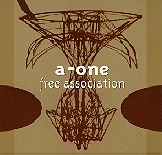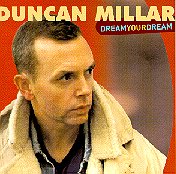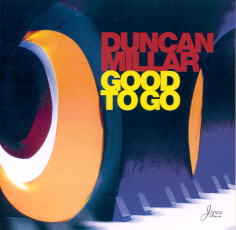|
I asked Duncan Millar about Smooth
Acid Jazz. He answered:
"I'm not sure if this is some
definite new movement or what?"
Not yet. But Smooth Jazz as a genre
or radio format needs new impulses, a renewal. Smooth Acid Jazz
would undoubtly be a possible model and as I will make evident
is already a practised way as a reviver.
Duncan explains further:
"I think smooth acid jazz is created mostly by UK or European-based producers. Their background is often not so much as musicians, but as producers, DJ's, programmers samplists etc. This is is distinct contrast to US-focused smooth-jazz, where the emphasis is on the style of a particular highly-accomplished musician, such as Rick Braun or Kenny
G. Often, they have had a lot of experience in independent dance music, and their compositional thoughts are centered on what people like to dance to. However, along with a taste for club-music, they also have a huge love of jazz-related groove music, which could mean anything from jazz to funk to soul, and probably have a huge record collection to prove it. All this is certainly true of Down to the Bone, who I used to work with in my West London studio making raucous house records before they started Down to the Bone. It is also true of Chris Bangs, whose background is as a DJ etc. I myself have a musician background, but I also did a
lot of house and trance music before A-One. It seemed quiet natural to transfer the way you think about that kind of music to working with more jazz-oriented
material with samplers, synths and drum-machines etc.
What makes smooth acid-jazz (if there is such a thing) different to acid-jazz is that the latter basically seemed to die off in the UK several years ago, although I think it could still be said to exist in a different form in trip-hop and chill-out music etc, and also is evident on European-based labels such as Compost Records. The club outlet was not really there anymore, but Jazz FM had started in London (still the only jazz-oriented station in London), which mostly favours the kind of music played on US radio, i.e. smooth jazz. Smooth jazz is more melodic and a piece tends to be structured more like a song that a free-form dance 12-inch. It was natural that considerations such as these would influence producers who wanted to continue their activities in acid-jazz."
Duncan
Millar is one of these artists bringing freshness into  Smooth
Jazz by using elements of Acid Jazz. Duncan
startet with his A-One
project. WOW Records released A-One's first single "West
By South West". WOW had also released tracks by other acid
jazz artists such as Heavy Shift and Diane Brown. It was
based in Notting Hill, West London, to which area A-One's studio
h Smooth
Jazz by using elements of Acid Jazz. Duncan
startet with his A-One
project. WOW Records released A-One's first single "West
By South West". WOW had also released tracks by other acid
jazz artists such as Heavy Shift and Diane Brown. It was
based in Notting Hill, West London, to which area A-One's studio
h ad
recently re-located, where it was occasionally made use of by
other bands and producers, notably Down to The Bone. The whole
album was finally released on Indochina Records, a subsidiary of
Warner Bros. (1994) and licensed by Trippin 'n' Rhythm Records
for the US market (1999). ad
recently re-located, where it was occasionally made use of by
other bands and producers, notably Down to The Bone. The whole
album was finally released on Indochina Records, a subsidiary of
Warner Bros. (1994) and licensed by Trippin 'n' Rhythm Records
for the US market (1999).
Duncan 's soundsamples of this album
on his website
are worth a listen. One can discover a certain similiarity to
the music of Down To The Bone or Soundscape UK. Typical is the
shuffle drum rhythm and the strong use of vibe sounds. In an
interview with Jeff Charney published on contemporaryjazz.com
David Benoit perfectly describes the sound as followed:
"A lot of it is
repetitious."
The pieces get a certain grooving
dynamic by the quick repetition of melody lines, which make them
hypnotic, dancable and attractive. By the way David Benoit is a
good example how the influence of Acid Jazz on Smooth Jazz is
measurable. Duncan regards his album as a fusion of his
interests in acid jazz and contemporary dance music.
His next album Duncan released under
his own name:
"Dream Your
Dream" represents both a progression as well as a
return to my original roots."
"Dream
Your Dream" was released in August 1998 on  Instinct
Records (Instinct Jazz) and in February 1999 in UK. Already the
first track "Little Ray Of Sunshine" makes it evident:
Duncan has a Smooth Jazz impact. The tunes are less agressive
more smooth, but still shines the acid jazz shuffle rhythm
through ("A New Day"). Thanks to Jazz FM Smooth Jazz
has a chance in UK too, and is gladly adapted. So we can listen
to much sax by Mike Smith and trumpet by Arden Hart and Ernie
McKone, who also produced mainly this album. I would compare
this developement with the history of the fine arts, when Rubens
and other artists were painting for their noble clients. Radio
stations can partly influence the evolution of music. Instinct
Records (Instinct Jazz) and in February 1999 in UK. Already the
first track "Little Ray Of Sunshine" makes it evident:
Duncan has a Smooth Jazz impact. The tunes are less agressive
more smooth, but still shines the acid jazz shuffle rhythm
through ("A New Day"). Thanks to Jazz FM Smooth Jazz
has a chance in UK too, and is gladly adapted. So we can listen
to much sax by Mike Smith and trumpet by Arden Hart and Ernie
McKone, who also produced mainly this album. I would compare
this developement with the history of the fine arts, when Rubens
and other artists were painting for their noble clients. Radio
stations can partly influence the evolution of music.
On the following album "Good
To Go" released  on
Instinct Records June 2001 one can assume a stronger influence
of Acid Jazz. "Super-Real Feel" starts as an uptempo
track with vibes, bass and the typical shuffle-beat. But strings
in the background and Chris Standring's smooth jazzy
improvisations makes it clear: we listen to Smooth Acid Jazz.
"One Warm Day" and "Sci-Fi Hi" are further
pieces in this style, the other tunes are pure Smooth Jazz. The
album was produced by Tony Campbell, who also played bass,
electric and acoustic guitars and drum programming on this
album. Tony Campbell has an own band "Nite Flyte" and
also remixed tunes of Gota and Soundscape UK. on
Instinct Records June 2001 one can assume a stronger influence
of Acid Jazz. "Super-Real Feel" starts as an uptempo
track with vibes, bass and the typical shuffle-beat. But strings
in the background and Chris Standring's smooth jazzy
improvisations makes it clear: we listen to Smooth Acid Jazz.
"One Warm Day" and "Sci-Fi Hi" are further
pieces in this style, the other tunes are pure Smooth Jazz. The
album was produced by Tony Campbell, who also played bass,
electric and acoustic guitars and drum programming on this
album. Tony Campbell has an own band "Nite Flyte" and
also remixed tunes of Gota and Soundscape UK.
Chris Mann comments this album:
"Did you
guess? I love the album, there’s not one track I don’t enjoy.
With some live drums and smoother fades on a couple of
tracks, yes, I’d say it would be perfect. On the sleeve photo, Duncan Millar looks like a young guy –
I for one hope he’s making music this good for a long
time."
Chris'
Digging Deeper
The albums received frequent
radioplay on Jazz FM, so  Ralph
Tee was motivated to license both albums for his Passion
Jazz label. The album was released under the title "Comin'
Thru" (2001). My personal thoughts about this album are written at
Firstview. Ralph
Tee was motivated to license both albums for his Passion
Jazz label. The album was released under the title "Comin'
Thru" (2001). My personal thoughts about this album are written at
Firstview.
Duncan withholds at his website www.duncanmillar.com
that he has a further project with the bassist Martin Klute
under the name "Voltage". You can listen to some
soundsamples at http://www.klute.co.uk/voltage.htm.
I hope that both find a label to release this new stuff.
<<<
>>>
|

